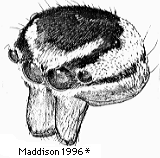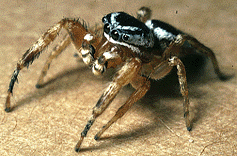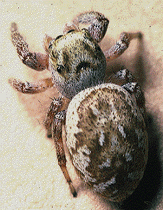Pelegrina kastoni
Introduction
The yellowish appendages and carapace stripes of males are similar to those of pervaga and sabinema, but the embolus and white bands on clypeus failing to meet at center are distinctive. The golden and beige females have distinctive epigynal flaps rotated 90 degrees inward.
Figures

 1
1
 2
2
 3
3
 4
4
 5
5
 6
6
 7
7- Male face
- Palpus
- Female abdomen
- Epigynum
- Male (Madera Cyn., AZ)
- Male (Madera Cyn., AZ)
- Female
Natural History
Primarily found on juniper. In my collections (17-19 June 1985) from oak-juniper-pine woodlands in south central Arizona, 9 males 17 females were beaten from junipers, 2 females from oaks and 1 males 3 females from Cercocarpus. Collected at elevations from 1200 to 2200 m. Most males collected in June (May-2 records, June-8, July-2, November-1); most females in June and July (June-7 records, July-5, August-2). Jung and Roth (1974) collected this species in their zone 2 in the Chiricahua Mountains (1460-1700 m elevation).About This Page
Included on this page are images and text from Maddison, W.P. 1996. Pelegrina Franganillo and other jumping spiders formerly placed in the genus Metaphidippus (Araneae: Salticidae). Bulletin of the Museum of Comparative Zoology. l54(4): 215-368. These images and text are copyright © 1996 The President and Fellows of Harvard CollegePage copyright © 1995 Wayne Maddison
All Rights Reserved.
Citing this page:
Tree of Life Web Project. 1995. Pelegrina kastoni . Version 01 January 1995 (under construction). http://tolweb.org/Pelegrina_kastoni/5053/1995.01.01 in The Tree of Life Web Project, http://tolweb.org/






 Go to quick links
Go to quick search
Go to navigation for this section of the ToL site
Go to detailed links for the ToL site
Go to quick links
Go to quick search
Go to navigation for this section of the ToL site
Go to detailed links for the ToL site